What Should You Do When Something Breaks?
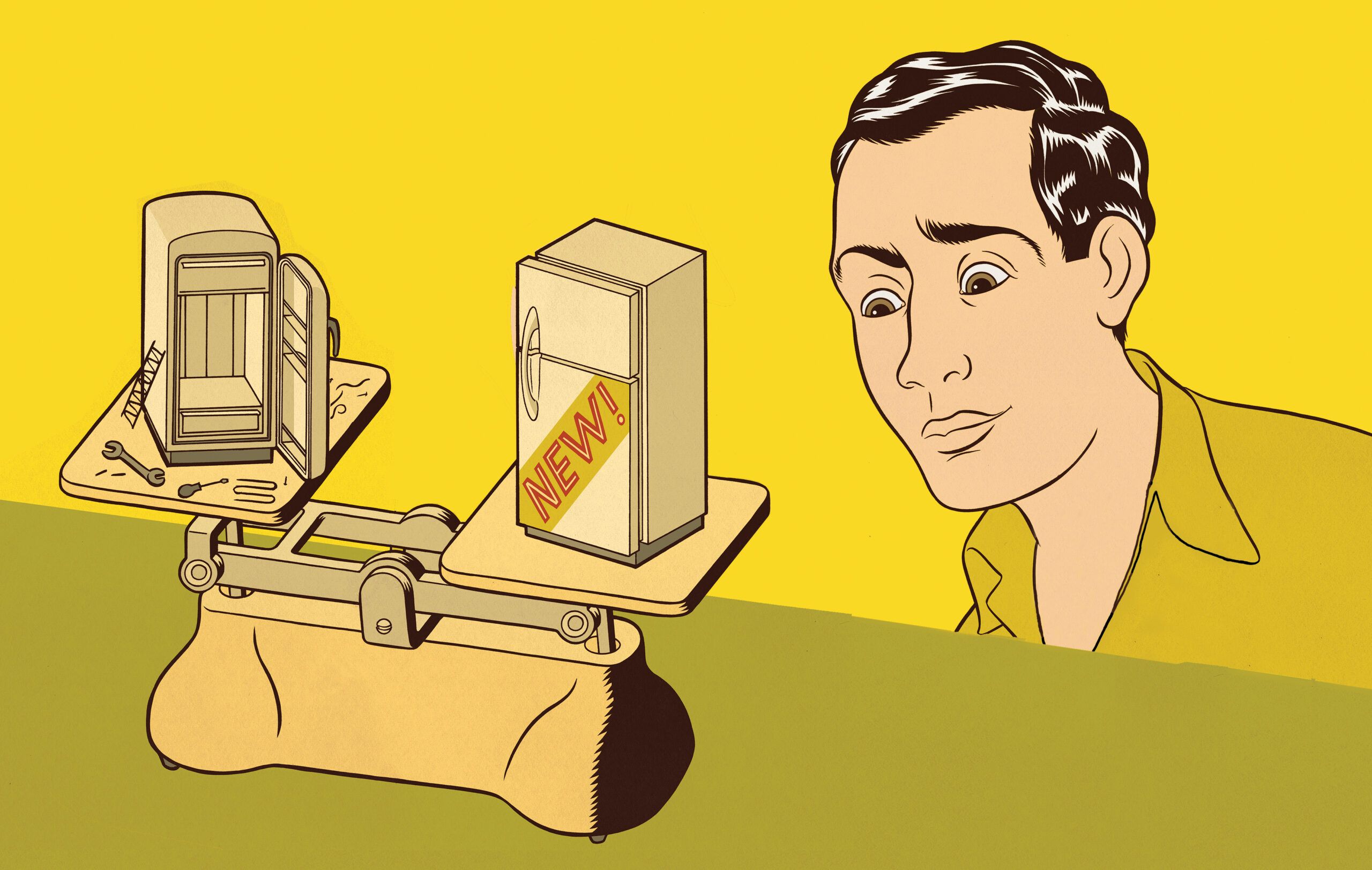
Given that, according to the 2017 American Housing Suvey, the average American home is 42 years old, new studies show you’ll reap better financial returns by investing in midrange repair and replacement projects than by ponying up for the high-end cosmetic upgrades. Factor in fixes that boost your home’s energy efficiency and you’ll recoup even more. But first, you need to weigh the short-term cost against the long-term benefits. Here, This Old House does the math on 9 common concerns.
Kitchen Appliances
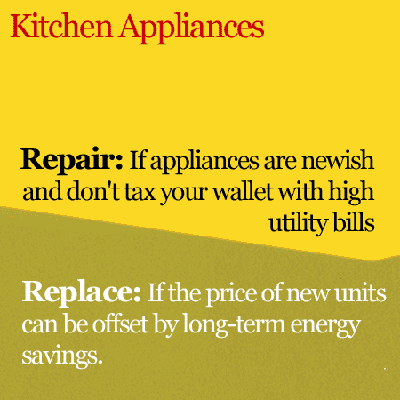
Energy savings alone can justify replacing a refrigerator or dishwasher. Swapping out a refrigerator over 10 years old for a new Energy Star model could save you $270 over 5 years. This energy savings may be enough for a cheaper model to pay for itself over its lifetime. A new Energy Star dishwasher, because it requires less water, saves 3,870 gallons of water every year, comapred to an older model. However, the difference in your bill only about $6 over the lifetime of the machine.
If your appliances are reasonably efficient but look dowdy, consider a DIY makeover. Panel kits from Frigo Design, which come in stainless steel, wood to match your cabinets, and even magnetic chalkboard, start at $399 for the fridge and $99 for the dishwasher. You can trim fridge energy costs yourself by installing a new door gasket (order one from the manufacturer) to give you a tighter seal so that cooled air won’t escape. You can also save by cranking up its temperature to a safe 38 degrees F and the freezer to 0 degrees F.
Leaky Windows
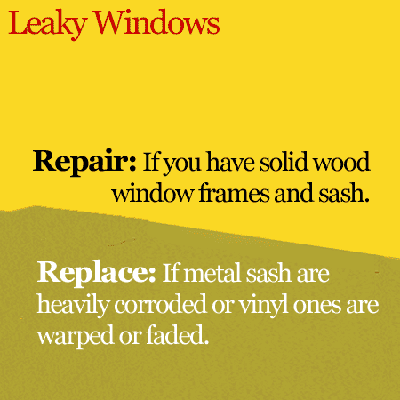
The wavy glass in your home’s old wood-clad windows stole your heart, but it might also be stealing your hard-earned money: up to 30% of home heating and cooling costs literally fly out those windows. Good news is, you can improve the efficiency of your existing windows for a lot less money than putting in new ones. On your side may be old-growth-timber frames, found in most homes built before 1950. The wood is more durable and stable than today’s plantation-grown stock. “You can’t buy a new window that will last as long,” says Dick Fritzer of in West Hartford, Connecticut, whose repairs have given many century-old windows another 100 years. You or your pro can significantly reduce air leakage in a double-hung by repairing sash damage, insulating weight pockets, and adding new weatherstripping. Add a storm window and you can match the efficiency of new double-pane units.
Drafty Front Door
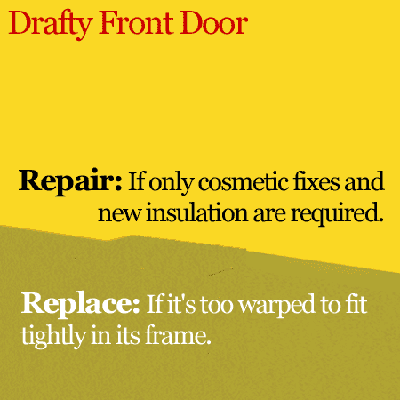
A solid-wood exterior door should last as long as the house it hangs in. You can fix most problems yourself, and do so economically, especially when the average cost for a door instalation is $942. If, for instance, you feel a winter chill when you run a hand around the door’s perimeter, your first defense is new weatherstripping. The old stuff gets stiff and cracks with age. For gaps smaller than ¼ inch, a 17-foot roll of closed-cell vinyl foam tape—enough to insulate any size door—will seal air leaks for less than $7. Bigger gaps require a new doorjamb kit and matching sweep for the bottom, and will run you $25. A sagging or ill-fitting door should be rehung first to ensure it’s centered correctly in the frame, says Michael Dresdner, a wood restorer in Puyallup, Washington. But if your door is warped or isn’t built to endure your climate, get a new one. In areas with extreme temperature fluctuations, for example, a wood door with multiple panels that can expand and contract within their frame will outlast a slab style.
Worn Wood Floors
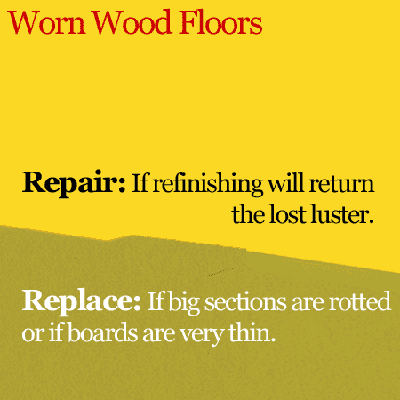
Hardwood holds up for 100 years or more. Problem is, without regular care, floors get dull and dingy. A screen-and-poly—a surface sanding and fresh coat of polyurethane —is the cheapest (about $1.50 per square foot) and speediest way to revitalize boards, says Don Conner, director of National Wood Flooring Association Certified Professionals Inc. Full-fledged refinishing, which can take days of sanding and multiple coats of stain and polyurethane, is a must if there are deep gouges or dents, or you want to change the color. Expect to pay up to $5 per square foot, depending on the wood type and how dark you stain. Lay new floor if the wood is too ruined for patching or you’re down to nails and can’t sand anymore.
Water-Guzzling Toilet
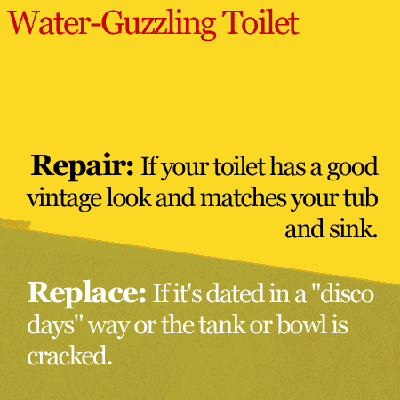
Okay, you’ve replaced your old tank’s worn-out flapper to stop the water from running. You’ve even pulled the whole thing out to fix a clog after your kid “accidentally” flushed a hairbrush. But you’re still squandering water. Toilets made before the 1930s, with their period looks and their satisfying whoosh, can use as much as 6 gallons per flush. To preserve aging sewage systems and cope with regional water shortages, federal law now requires new toilets to gulp no more than 1.6 gallons. Rather than buy a new low-flow model, save yourself $200 or more by swapping out the mechanisms in your old toilet with the water-conserving ones in a universal repair kit, sold at hardware stores for about $20.
Blown Electrical Fuses

The lights still go out every time you turn on your plasma-screen TV, even though you’ve swapped the old two-prong outlet in your den for a new three-prong version. Electrical systems in old houses are often incapable of supporting today’s accumulating gadgetry, and overload can lead to surges that destroy electronics or spark fires. Signs that it’s time to replace the electrical system include frequently blown fuses, tripped circuit breakers, and lights that flicker or dim when an energy sucker kicks on.
To get a handle on what’s lurking behind the walls, get an assessment by an electrical inspector. Find one in your area through the city or county building-inspection department. Work will likely include upgrading the electrical panel, replacing cloth-wrapped wiring with new plastic insulated lines, and grounding outlets. Prices vary widely for a whole-house electrical revamp. When mulling over the bids, it’s best to go with a licensed and bonded electrician with a track record of updating older homes.
Repair: If your electrical panel is up-to-date, your electrician may be able to add a line.
Dripping Faucet
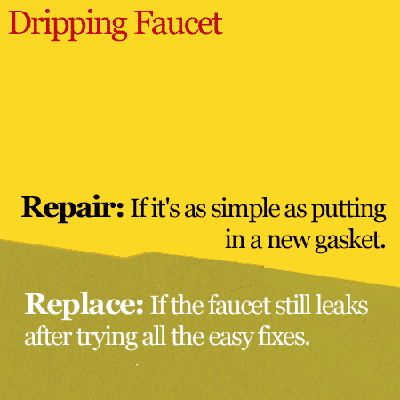
Most leaks are fixed with a wrench and some inexpensive replacement parts. New washers, O-rings, and stem cartridges run from $4 to $12, though some for fancy European faucets can cost four times more. If repairs are never-ending or debris from your pipes is lodged inside the faucet, spring for a whole new setup. New bathroom-sink faucets start at $25 and kitchen models at $50; double that for more cutting-edge styles and fancy finishes. New faucets should last 15 to 20 years, says Thomas Annunziata of Park Slope Plumbing Supply, in Brooklyn, New York. “But the inside’s what counts,” he says. He recommends a brass stem and warns against short-lived plastic parts.
Shabby Shower Tile
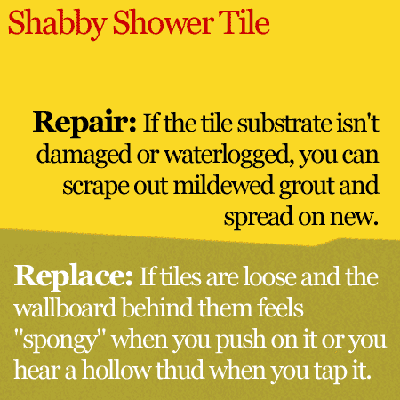
You’ve taken a bleach-soaked toothbrush to the mildewed grout and applied new caulk where tile meets tub. Yet in no time, the mold is back, black, and gross all over. This could be the sign of a more serious problem lurking under the surface. Over time, water can get into voids between tiles and turn wallboard to mush, says Bart Bettiga, executive director of the National Tile Contractors Association. It can also cause tiles to buckle. The only remedy is to remove the tiles and replace rotten wallboard with a waterproof material, such as fiber cement (“green board” is no longer recommended in wet areas). Be warned: Mold can be toxic and make you sick. Find out what’s growing and do demo with caution, says Bettiga. It’s also easy to break tiles when you pull them out, so plan to put in new ones or have matching replacements on hand.
Rusty Rain Gutters

Corroded or leaky gutters and downspouts can cause water to pool around your foundation and seep into the house. If it’s just a matter of fixing a loose joint in an aluminum gutter, for instance, you can avert disaster yourself. Just wash the damaged area with denatured alcohol and apply a sealant, such as Geocel’s Instant Gutter Seal ($8 or less at hardware stores), says Tony Cobb, founder of the National Rain Gutter Contractors Association. If you have steel gutters that are riddled with rust holes, you’re better off replacing them. Contractors typically charge a minimum of $150 to $500 for minor repairs, while installing new gutters can range from $573-$1,429. The job will last 20 to 25 years, says Cobb. If you have copper gutters, always try repairs first. The soaring cost of the metal can make them prohibitively expensive to replace. Plus, their distinctive look and 70-year life span make them worth preserving.
Looking for help with repairs around your home? A home warranty may help. Check out these in-depth guides from the This Old House Reviews Team:
